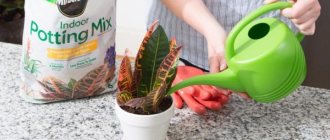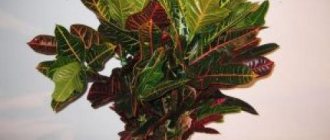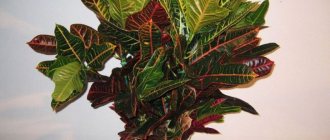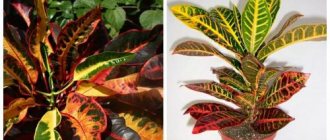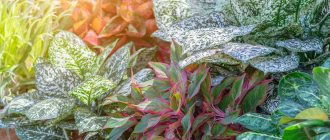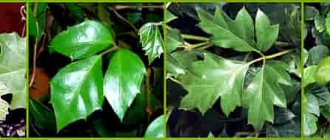The codiaeum flower, otherwise croton, is the most famous Codiaeum variegatum var. pictum, has numerous varieties of different leaf shapes and colors.
It was first described in 1690 by the naturalist and gardener Rumphis, a Dutchman by birth. It is a perennial shrub, reaching a height of up to 4 m in the wild or special greenhouses, and up to 70 cm in indoor conditions. It is a perennial plant of the Euphorbiaceae family. Southeast Asia is considered its homeland.
It has an erect, branched trunk covered with large leaves, up to 30 cm in length. In describing the foliage of codiaum, it is worth mentioning its great diversity. There is no classic or standard appearance for this flower. Leathery leaves can be narrow, long, wide or oval; wavy, jagged or twisted into a spiral. In addition, as the plant ages, the color and shape of the leaves often change.
How the indoor ornamental plant codeium blooms
In its appearance, the flower combines all the shades of the autumn palette. Color varies from yellow and green to orange and red with a finely speckled pattern, with spots, stripes or prominent veins. There are even dark brown, almost black leaves with bright veins. The older the leaf, the brighter its color. It is this riot of colors that attracts the attention of both professional plant growers and amateurs.
The bright codiaum blooms, like many decorative foliage plants, faded and inconspicuously - with small white or barely yellowish flowers, collected in small racemes of 15-20 pieces. Both female and male flowers grow. Male representatives can be recognized by the fluffy stamens on each slightly curled petal, and female representatives by three curved petals.
This rather fastidious plant can grow for more than 15 years under proper conditions. Looks great in spacious, bright rooms, winter gardens and verandas. It is popular among regulars of greenhouse exhibitions and artificial gardens.
For initial reference, below are photos of a beautiful codiaum flower (including a blooming specimen) - study them.
Appearance of Aucuba
Aucuba is a shrub with large decorative leaves.
Aucuba very rarely blooms at home. But when this happens, small apical inflorescences of a red hue appear on it. Against the background of green, leathery, oval-shaped leaves with a serrated edge and golden spots across their entire surface, they look very beautiful. If female and male specimens grow nearby, then after flowering original oblong red fruits are formed, reminiscent in appearance of the berries of dogwood plants. They appear at the end of winter, beginning of spring.
The stem of the plant has woody properties. The leaves on it grow opposite. Their size can reach 20 cm in length and 7 cm in width. The height of aucuba at home can reach two meters.
Possible problems in growing
The leaves are turning pale
The leaf blade loses its color if there is very little lighting in the room.
Transparent or light spots on leaves
The leaf blade may completely lighten (become almost white), or pale spots may appear on it. This is the first sign that the plant is in too much light. Also, drafts can cause such a reaction in croton.
The tips of the leaves are drying out
Dried tips of a flower or brown spots appearing all over the leaf blade indicate that the room is very dry, or the plant is not watered in sufficient quantities. Sometimes the tips can dry out because the codiaum is very cold in the apartment.
The lower leaves fall off
This is a natural process in an adult plant. With age, Croton, stretching out, sheds its lower leaves, so there is no reason to worry about this.
Pests
The main enemy of the flowerpot is the spider mite. The backs of the leaves should be checked every 10 days. If there is even a subtle hint of a mite on the leaf blade, you should immediately spray it with an insecticide or prepare the medicine yourself. To do this, make a soap solution from dark laundry soap. Wipe the leaves and stem with a moistened cotton pad. Such actions should be repeated after five days 3-4 times.
Croton is quite demanding in terms of care; it periodically requires a period of rest. For example, when cared for at home, Codium Excelent can darken and shed almost all its leaves if the tree is not properly cared for.
Popular varieties of aucuba
Thanks to the work of specialists from different countries, various varieties of aucuba can now be found on sale. Among them there are plants with green leaves and only in the center or along the edge there are small yellow spots. Some, on the contrary, sparkle with a golden sheen, drowning out the main green background of the leaves. Japanese and Himalayan aucuba are most often grown indoors:
- Japanese aucuba (Aucuba japonica). It grows naturally in the south of the Korean Peninsula and in Japan. There are varieties with green leaves and spotted forms. This species has a large number of forms with yellow spots of different sizes and locations on the leaves. The color of the berries can be not only red, but yellow and white. A beautiful bush-like form can only be created through regular spring pruning. It is recommended to use it as a separately growing tub bush.
A. japonica
- Himalayan aucuba (Aucuba himalaica). The Eastern Himalayas are considered the homeland of the evergreen shrub. A dioecious plant with long pointed leaves that blooms in March and bears red fruits. Loves diffused sunlight and tolerates light shade well. It definitely requires regular pruning of fast-growing shoots.
A. himalayan
Aucuba care at home
Aucuba is a simple, unpretentious indoor plant. But in order for it to sparkle with bright natural colors, you still need to follow certain rules for caring for it.
Aucuba planting
In the same pot, this plant can live and develop successfully for up to 10 years. This must be kept in mind when planting a seedling. A large pot must have good drainage and be sure to have a hole in the bottom of the bowl. The soil mixture must be composed of sand, turf soil and peat. The components are taken in equal quantities. An adult plant is transplanted by carefully transferring it into another container. A sign indicating the need for this procedure is filling the entire volume of the pot with a large number of roots.
Common varieties
Croton flower - leaves falling. Causes
Since the 19th century, Variegatum has been grown as a houseplant - the only croton known at that time; species and varieties with various colors became known many years later.
Excellent
A beautiful oak-leaved codiaum. A tree with a strict crown structure that forms one central trunk. The Codium Excellent flower has large leaf blades that are located along the shoot, resembling a tiled structure. In the upper part of the trunk, the leaves are more saturated in color: from greenish-yellow to red-burgundy. The leaves of Croton Excellent are greener at the bottom, with pronounced lightish veins.
Variegatum
Another popular name for it is “decorated”. Today, Codiaum Variegatum can be found in the wild in China. Landscape designers of this country prefer to use it as a landscaping material in Beijing to create a unique atmosphere. It can also be found in Pakistan. The plant can grow up to 2.5-3 meters in height. The trunk is formed bare at the bottom, at a height of 10-20 cm the first leaves begin to appear. They have an elongated lanceolate shape, ovoid at the base. The color is dominated by green and brown tones. Due to the fact that many cannot accurately determine the name of the variety or species, the name croton or codiaum variegated is most often used by the people.
Croton Variegated
A variety of this interesting representative is Codiaum Variegatum Mix. There is no exact information about what variety croton belongs to. Bright, wavy, slightly curled leaves add more character to this tree.
Another representative of Codiaum Variegatum was the Moluccan variety. The leaves are wide at the bottom, narrower at the top, and have a slightly ovoid shape. There is also the Minus variety, which has completely elongated thin leaves.
The Genuine form of the plant has flat, wide, lanceolate leaves. They taper towards the base. On the surface of the plate you can observe an unusual pattern of golden and silver colors, sometimes this picture takes on a reddish tint.
Mammy
Croton Mammi is a bright plant with multi-colored leaf plates that are very densely located along the shoots. A young plant has yellowish-green leaves, while an older croton changes its shade to red, then red-brown. A very old plant may have completely black leaf blades. A special feature of the variety is the shape of the leaf blade, which twists slightly during growth. Some leaves can curl so tightly that their ligulate (original) shape is completely lost.
Mrs Eyeston
Croton Mrs. Iceton has a large number of admirers. This is an interesting variety due to the unusual shape of the leaf blade. The leaves are broad, rounded at the ends, and flat. Young trees have a soft creamy plate tone, older trees begin to acquire different shades of specks: from pink to red and yellow. The spotted flower becomes brighter with age, allowing the plant to look more interesting.
There are several varieties of this variety:
- Codiaum Aiston red. A plant with red or dark red leaves; the leaf blades may be completely black at the bottom.
- Iceton is yellow. Its leaf blades are completely yellow and may be orange.
- Disraeli Codiaeum. Green-red leaves with yellow veins.
- Black Prince. A variety with green leaves with red and yellow speckles.
Croton angustifolia
Narrow-leaved codiaum has long, up to 20 cm, but very thin leaves. On the green base there may be bright spots of yellow or red. Among the representatives of this variety is the Croton Pictum Spot. The thin-leaved flower resembles a palm tree with brightly colored variegated leaves.
Codiaum aucubifolia
A wonderful plant that will decorate any home. The leaves of the tree are green with yellow fragments, but the color is unevenly distributed over them. On one sheet you can observe bright and dull shades.
How aucuba blooms: photo and description
Aucuba is a decorative-leaved, semi-lignified plant ; in a room its height reaches no more than 50-60 cm. In nature, aucuba grows up to 5 m in height. The initially green stem of the plant becomes woody with age.
The leaves are short-petioled, dense, leathery , with a large number of yellow or white spots scattered on a dark green background; the leaf blade is large, ovoid-oval or oblong (in the latter case, the edge is finely serrated). The flowers are small, on short stalks.
These photos show how aucuba blooms:
After flowering it produces very showy red fruits. The fruits are small and very poisonous. A popular, very unpretentious crop for cool rooms. Since aucuba is a dioecious plant, in order for it to bear fruit, it is necessary to have male and female specimens.
It rarely blooms indoors, in March-April.
The most popular types and varieties include:
Japanese aucuba 'Variegata' (A.japonica 'Variegata')
Japanese aucuba 'Dentata' (A. japonica 'Dentata')
Japanese aucuba 'Hillieri' (A.japonica 'Hillieri')
In indoor culture conditions, only Japanese aucuba (A. japonica) is grown.
Of greater interest are not monochromatic green plants, but varieties with variegated leaves covered with yellow spots or specks:
Crotonia
Picturata Variegata
Look at a selection of photos of indoor aucuba flowers of various types:
Below is how to care for aucuba at home.
Variegated garden plants
Crops growing in open ground with original foliage colors are no less beautiful. There are slightly fewer of these than indoor ones, especially among flowers that are able to survive in the Russian winter. Most garden variegated plants have a green-white color, but there are also bushes with yellow-green or red-green foliage. Every gardener can choose a plant to their liking, be it a ground cover or a large bush.
In our climate, the most commonly grown are:
- Heuchera. An evergreen perennial with round or heart-shaped leaves on long petioles.
- Lungwort. Medicinal perennial with spotted leaves.
- Brunner. Sprawling perennial bush with white-green foliage.
- Loosestrife. Variegated varieties have dotted loosestrife: Alexander with a white border and Golden Alexander with a yellow border.
- Tenacious. Perennial ground cover.
How to care for an aucuba plant at home (with video)
Optimal location: all exposures except the south. In summer, the aucuba can be taken outside, but it should be positioned so that it is protected from sunlight, wind and rain.
Temperature requirements: in summer it prefers moderate temperatures, about 20 °C; at higher temperatures the plant quickly ages and loses its leaves. In winter, it is preferable to maintain the air temperature from 8 to 14 °C, but not lower than 5 °C.
Lighting requirements: Aucuba grows well in both bright and shaded areas, but bright, diffused light, without direct sunlight, is preferable. When growing aucuba in winter, the plant requires good lighting.
Watering, spraying: in summer, water abundantly, but so that the top layer of the substrate dries out slightly between waterings. In the autumn-winter period, water moderately. Due to excessive soil moisture, black spots may appear on the leaves. The dry air in summer is calm. Tolerates dry air, but spraying is necessary in the autumn-winter period. For watering and spraying, use soft warm water. When keeping the plant in a room with a temperature between 6–12 °C, spraying should be carried out carefully to exclude fungal diseases.
Feeding: during growth in spring and summer, once a week with mineral and organic fertilizers. When caring for an aucuba flower, feeding should be alternated.
Replanting: Aucuba is one of the crops that do not need frequent replanting, so replant a young plant no more than once every 3–4 years, and an adult plant once every 5–6 years.
You need to replant carefully, as aucuba has fragile and brittle roots. It is best to transfer the plant without destroying the earthen ball into a pot of larger diameter. Pots for growing aucuba should be wide.
In hydroponic culture and when grown on an ion exchange substrate, plants grow well for a long time without transplanting or fertilizing.
Substrate: a mixture of clay-turf, leaf soil, peat and sand (6: 2: 2: 1) or turf, leaf soil, humus, peat and sand (2: 1: 1: 1: 1).
Pruning: in the spring, at the beginning of the growing season, aucuba is pruned. Also, for better tillering, young shoots are pinched.
So, in spring and summer, abundant watering and spraying are necessary, in winter watering is moderate. Fertilizing with complete mineral fertilizer is carried out monthly only during the growing season. Once every two years, the plant is transplanted into fresh substrate and large dishes.
Watch how to care for your aucuba in this video:
Features of home care
Nettle or Coleus houseplant
Croton is quite easy to care for. It can live well in the shade, but the best place to stay is the sunny side with diffused light. It is better to avoid places with direct sunlight, as the leaves will get burned.
Croton, care
Healthy. If the flower has green leaves, and it is necessary for it to have more variegated colors, it should be placed in a brighter place.
Temperature
The ideal temperature for croton is 20-24 degrees Celsius. Extremely low temperatures cause root rot and leaf drop.
Watering
Watering the flowerpot is carried out as the soil surface dries out. In winter, croton is watered even less frequently.
Spraying and maintaining humidity
Croton needs high air humidity. Therefore, it needs daily spraying. Once a week you can rinse it with a shower.
Priming
Soil for croton can be purchased at a flower shop or made yourself. For home soil you will need:
- leaf soil (1 part);
- turf land (2 parts);
- rotted manure (1 part);
- peat (1 part);
- river sand (0.5 parts).
Before use, 2 parts of charcoal are added to the finished mixture. It acts as a disinfectant in the mixture. Additionally, before sowing, they are shed with a solution of potassium permanganate.
Feeding
You can fertilize the flowerpot in spring and summer. In winter - once a month, in spring-summer - once a week. Under no circumstances should you pour fertilizer onto the dry soil of a flowerpot. First, the pot is watered with plain water.
Interesting. Flowering of codiaum is a rather rare phenomenon, but not everyone can notice it, since the buds of the plant are very inconspicuous. The flowers are collected in a racemose inflorescence. Many gardeners, when croton blooms, without planning to propagate the seeds of this tree, pluck out the buds so that the plant does not waste nutrients and energy on the formation of inflorescences and seeds.
Trimming
It is necessary to care for Croton throughout its life. The main point in care is pruning.
Croton pruning
The importance of pruning in home care:
- Plant formation;
- Awakening the flower to growth;
- Stimulating the tree to produce side shoots;
- Renewal of the vegetative part;
- Removing damaged parts of codiaum.
The circumcision procedure must be carried out with a new, clean and sharp knife.
Before using the knife, it must be treated with alcohol or fungicide. This is done in order to prevent the appearance of diseases after pruning. The cut area is sprinkled with charcoal crushed to a powder state and left for a while to dry. Do not treat with any antiseptic agents for 7-9 days after the procedure.
In addition to the main pruning procedure, flower stalks and buds are also removed. Caring for the cut areas is the same.
Reproduction of aucuba at home by cuttings and seeds
Aucuba is propagated at home by cuttings and seeds.
Seeds are sown immediately after collection, as they quickly lose their viability. It should also be remembered that during seed propagation, varietal characteristics may not be transmitted. Seeds are sown in a moist substrate (peat and sand), covered with glass or a transparent bag, maintained at a temperature of 21 °C, constantly sprayed and ventilated regularly. Shoots appear after a long time. When the seedlings have 2-3 leaves, they are planted in separate pots.
When propagating aucuba by apical cuttings, they are cut in March - April or August - September from shoots of last year's growth. Root in damp sand or a mixture of peat and sand in a greenhouse, maintaining the temperature within 20–22 °C, constantly spraying and ventilating regularly. After the cuttings take root, they are planted in appropriate pots (7–8 cm) in a mixture consisting of turf soil, humus and sand (1: 1: 1/2).
Diseases and properties of aucuba
If it is not possible to provide a cool winter and the plant is kept at room temperature, frequent spraying and good lighting are necessary. At higher winter temperatures, aucuba may shed its leaves. The following problems may also occur: the number of yellow spots on the leaves is reduced (lack of light and nutrition), the leaves turn pale (too bright light), become smaller (lack of fertilizer), fall off (too dry air and high room temperature), the lower leaves turn yellow and premature fall off (irregular watering or sudden temperature fluctuations), the top of the leaf dries out, the leaves turn yellow and fade (excess light), the edges of the leaves dry out (insufficient watering in summer or dry air in winter), black spots on the leaves (overwintering is too warm and dry).
Common diseases of aucuba include late blight - a fungal disease that manifests itself in the fact that brownish-purple spots appear on the leaves, then they turn black, the neck of the plant rots, which soon withers and dies. There are two reasons - either excessive watering or compacted substrate. Since there is no treatment, it is necessary to get rid of the plant along with the pot as soon as possible.
Attention! Aucuba berries and all parts of the plant are poisonous and can cause inflammation of the stomach and intestines, diarrhea and blood in the urine. You need to be careful when working with the plant.
Aucuba is not only an ornamental plant, but also a medicinal plant. In its homeland, Japan, the fruits and leaves are used in folk medicine. To do this, crushed fruits in the form of bandages are applied to superficial wounds. For various types of burns, crushed leaves of the plant are used and applied to the affected areas.
Aucuba has the amazing ability to influence the atmosphere of the home, introducing a spirit of peace and unity. This plant is especially recommended for those in whose home there live self-centered people who are overly confident in their importance.
- Author: Maria Sukhorukikh
Rate this article:
- 5
- 4
- 3
- 2
- 1
(1 vote, average: 5 out of 5)
Share with your friends!
Corokia cotoneaster
One of the most interesting house plants. It has tangled dense branches and at the same time an almost transparent crown. The height of the bush is from 30 to 80 cm, it can easily be given any shape.
The small, yellow, star-shaped flowers smell pleasant. Corokia loves bright light, cool temperatures, and moderate watering.
The zigzag growing branches create an unusual tangled lace appearance.
This exotic specimen prefers cool weather, especially during wintering. In summer it needs to be taken out into the fresh air more often.
